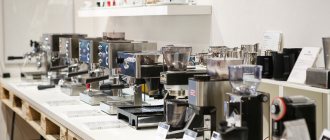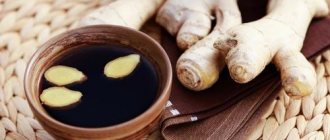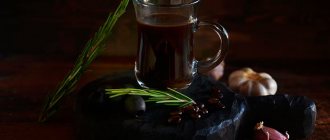It’s not always possible to have a coffee machine or pot at hand to brew a portion of your favorite drink, and instant, although convenient to use, is not to everyone’s taste. There is an elegant, and most importantly, simple way out of this situation - pour ground coffee directly into a cup without any cooking, pour in slightly cooled boiling water and enjoy.
It is surprising that this preparation option seems strange to many, but in the 18th century, when ground coffee began to gain popularity among Europeans, it was brewed this way. Coffee pots, called percolators, appeared a little later - at the beginning of the 19th century.
A moment of history
Already in the 18th century, Europeans adored freshly brewed natural coffee, but did not use Turks to prepare it. Then it was believed that the boiling process could affect the taste of the drink, so a popular method for preparing this drink was in which the ground grains were simply poured with hot water and thoroughly infused in a coffee pot. For filtration, a linen bag was used, which played the role of a modern paper bag and did not allow particles of grounds to fall into the cup.
However, in the 19th century, the methods of preparing coffee changed greatly. Coffee makers of various designs appeared and the previous fashion was practically forgotten. But, of course, there were also dedicated gourmets who continued the ancient traditions, brewing ground grains directly in a cup, which made it possible to better reveal the taste of the drink and transmit subtle aromas.
In the 90s of the last century, the fashion for brewing coffee in a cup returned again. The old method is used by ordinary people who are fed up with instant coffee, but do not want, or do not have the opportunity to use a coffee maker.
Is it possible to drink expired coffee?
Most products, when expired, become potentially dangerous to humans. As for coffee, it only loses some of its aroma if its expiration date has expired . Although this is enough for lovers of an invigorating drink to throw away the expired product.
Less picky people can use this type of coffee if it has been stored reliably for, for example, 3 years (with a shelf life of 2 years), since it can be used to make a good, albeit not so fragrant, drink. In addition, it will be less strong, because the amount of caffeine decreases during long-term storage.
The effect of ground coffee on the human body, positive and negative aspects
An instant drink has a chemical composition that is far from a natural product, while ground coffee, which is not boiled, retains maximum natural properties that have an effect on the human body.
In addition to the caffeine itself, which is part of coffee, ground beans contain numerous natural oils and fats (lipids), organic acids, minerals and tannins, vitamins E, B and PP, as well as proteins and carbohydrates, which are beneficial for our health.
This composition has a positive effect on the body, which consists of the following points:
- increased vigor and body tone;
- dulling the feeling of hunger (therefore the drink is often used for weight loss);
- breakdown of fat cells;
- improved concentration and brain activity;
- the risk of some diseases is significantly reduced, for example, prostate cancer by 25%;
- slowing down cellular aging of the body;
- Improved mood and overall positive outlook on life due to stimulation of brain hormones.
With significant abuse of ground coffee, there may be negative consequences:
- development of insomnia;
- increased vascular pressure;
- risk of heart attack;
- migraine;
- problems with conceiving and bearing a child;
- leaching of calcium from the body;
- decreased hearing level.
We can say that the worst negative consequence is death from taking a lethal dose of caffeine, which is 10-15 grams. However, this amount of the substance is contained in 80-120 cups, so in practice it is almost impossible to die from your favorite drink, although it is clearly not worth abusing it.
For you:
Baileys coffee - exquisite “Irish” taste and unique aroma
How to brew coffee using a Chemex?
Not all people have the opportunity to purchase a professional coffee machine. But this does not mean that they cannot enjoy the taste of good coffee. One alternative way to brew a drink is to use a special device called a Chemex. Visually, it is a glass flask, shaped like an hourglass, made from a paper filter. All that remains is to figure out how to prepare ground coffee using this device. Step-by-step actions in this case will be as follows:
- Moisten the paper filter with clean water.
- Pour the required amount of ground coffee into it.
- Prepare hot water (temperature 90-94 °C).
- Carefully and slowly pour water into the filter up to the 450 ml mark (for 32 g of ground coffee).
- In 4 minutes the drink will be ready. It should be noted that the coarser the grind, the longer the coffee needs to brew.
Water used to brew real coffee in a cup
Almost all methods of preparing natural coffee in a cup are similar in their recipe: ground beans are poured into a container, water of a certain temperature is poured, and the drink is infused for a certain amount of time. The temperature of the water depends on the specific recipe, which can be either hot or cold. However, you should not use boiled or chlorinated water, as it can ruin the taste of your drink.
Soft water from a spring, well or artesian well is best. It is preferable to take bottled water with a mineralization level of 150 mg/l and ensure that this parameter does not exceed 250 mg/l.
If a recipe calls for using hot water, it should never be brought to a boil. Usually, the container with liquid is removed from the stove when the first bubbles appear and the water just begins to boil. At this moment, her temperature ranges from +92 to +96 degrees Celsius!
It is better to use a ceramic brewing cup with thick walls. To obtain 80-110ml of finished drink, the volume of your cup should be 120-150ml, taking into account the space for the swollen grounds.
Immediately before brewing, it is better to pour hot water over the cup. So, it will take longer to cool down.
French press for making coffee
It’s not difficult to brew an invigorating drink using a French press. Visually, a French press is a special closed container with a piston. To prepare a drink using this device, coarse coffee beans are required. Otherwise, it will be more difficult to push the piston with the filter. But grinding does not affect the taste of the drink. In any case, the coffee will be excellent.
The cooking process consists of the following steps:
- Boil water in a kettle, then let it cool slightly to a temperature of 90-95 °C.
- Pour ground coffee into a French press at the rate of 7 g per 100 ml of liquid.
- Pour a small amount of water (about 100 ml) into the container and stir the coffee with a spoon.
- Wait exactly 1 minute, then pour the remaining water into the French press.
- Close the container with a lid. Wait another 3 minutes.
- Carefully lower the piston all the way. Pour the drink into preheated cups.
Types and degree of grinding of natural grains
Many gourmets prefer to use only freshly ground coffee beans, as they rightly believe that this product is capable of providing the unique taste of the drink. However, this is not always possible, especially during a break at the office or in the morning, when there is very little time left before going to work.
Nowadays, there are many brands of excellent ground coffee, which are only slightly inferior to fresh, home-prepared powder. The main rule for preserving taste is hermetically sealed packaging, which will prevent the aroma from eroding.
If you want to get the maximum aroma, you can buy coffee in stores that specialize in it, where it is ground before your eyes to the required degree of grinding.
To brew in a cup, take those types of coffee that have special markings. However, this is not critical, and it is quite possible to use medium or fine grinding grains. With greater dispersion, coffee particles float and require catching with a spoon; with extremely fine dust, a suspension is formed that requires particularly careful filtration.
The following single varieties are suitable for brewing in a cup:
- Ethiopian and Yemeni Arabica with fruity notes;
- Brazilian Arabica with a slight acidity and mild taste;
- South American Arabica with citrus and chocolate bouquet;
- Indian and Kenyan Arabica with a pronounced chocolate aftertaste.
If you buy coffee in packs, check the composition to see if it contains robusta. It's better if it's not contained. It gives strength to the drink, which is already sufficient when brewed in a cup. In addition, robusta affects the taste, making the drink bitter.
Coffee for coffee machine and carob coffee maker
If you are interested in professional products intended exclusively for preparation in a carob-type coffee maker or a traditional coffee machine with all the specifics that accompany it, then you can again use the rating tips from Otzovik and Ozon.
Jockey "Eastern"
Price – 168 rub. for 250 g
And budget coffee can be of high quality, as evidenced by Russian products made from 100 percent finely ground Arabica coffee with dark roasting. The result is always pleasantly impressive - the coffee is rich and aromatic, with a long-lasting aftertaste and an invigorating effect.
Advantages and disadvantages
strong, aromatic coffee;
suitable for coffee machine;
reliable packaging;
affordable price.
not identified for this cost.
Egoiste Velvet
Price – 289 rub. for 200 g
And again Egoist, only “Velvet”, which is supported not only by the name of the product, but also by the most pleasant organoleptic qualities. To prepare this medium roast ground coffee, only single Arabica beans were used, without GMOs or other impurities.
A distinctive characteristic is light wine notes in the taste and a pleasant fruity aftertaste that cannot leave anyone indifferent.
Advantages and disadvantages
very aromatic and tasty coffee with a lasting invigorating effect;
high-quality packaging;
composition, roasting and grinding of beans - no complaints.
high price.
Methods of brewing in a cup
There are five basic cup brewing methods:
- Brazilian;
- Polish;
- Cuban;
- in the microwave;
- cold
The powder is measured with a teaspoon, which can hold 3 grams of finely ground grains without a heap, and 5-6 grams with a heap. The drink brewed in a cup can be diluted with milk, decorated with whipped cream and sweetened with syrups.
For you:
Coffee with condensed milk is a delicious drink for those with a sweet tooth
Brazilian method
Real tasters use this method to evaluate the taste of a drink. It requires coarse grains.
The heated cup is filled with ground coffee, which is covered with hot water. There are 8-9 grams per 100 ml of water. The drink is infused for 4-5 minutes.
The coarsely ground parts float to the surface to form a crust. It prevents the drink from cooling quickly. Remove the crust with a teaspoon after steeping.
Polish method
Good for cooking in the office. Medium grinding grains are required, in proportions of 6-7 grams per 100 ml of water.
The recipe looks like this:
- The heated cup is filled with coffee.
- Sugar and spices are added to taste.
- Add a little hot water to lightly cover the contents of the cup.
- The resulting grounds are mixed very thoroughly for 10-15 seconds.
- The rest of the water is added.
- The cup is covered with a saucer and infused for 3-4 minutes.
Sugar is added immediately so as not to raise the suspension of the finished drink, which settles during infusion. Intensive mixing is necessary for the formation of foam and uniform distribution of the dispersion. If you use spices, they must first be mixed with ground coffee in dry form. This is done so that their particles do not float to the surface while adding water.
Cuban method
Identical to Polish except for some details:
- prepared in a glass glass in a large portion, about 200 grams;
- The strength of the drink is ensured by the proportions of 8-9 grams of coffee per 100 ml of water;
- You can only use cane sugar;
- add 1-2 teaspoons of dark rum to taste.
Microwave brewing method
Essentially, this is an advanced method that is similar to brewing in a Turk. It requires 6-7 grams of fine or medium grind coffee beans for every 100 ml of water.
Recipe:
- Coffee is poured into a cup, spices or sugar are added to taste.
- A little cold water is added to the cup and the contents are stirred for 10-15 seconds.
- The rest of the water is added, the level of which should not reach the edges of the cup by 3-4 cm.
- Place the cup in the microwave and turn it on.
- You should monitor the coffee through the transparent door and remove it when the foam begins to approach the edges.
- After brewing, the coffee is poured into another cup, rinsed with hot water, and infused for 3-4 minutes.
Cold brew method in a cup
This is a great way to make iced coffee in hot weather. It's easy to implement at home:
- Ground coffee is poured into a cup in the evening in the proportions of 10 grams per 100 ml of water.
- The cup is filled with cold water.
- In the morning, after 12 hours of infusion, cold coffee is ready to drink.
This coffee can be brewed at work, if there is a refrigerator there, or just a secluded place. During infusion, it is better to cover the container with a lid. The finished drink does not require dilution.
Shelf life: how long does it last after opening?
Information about the expiration date of coffee is always placed on the packaging, and it cannot be neglected: it can differ significantly for different types of product.
Ground coffee in foil and multilayer bags with a valve, jars with tight lids, as a rule, is stored for a year. In vacuum packaging - about three years. If the packaging is opened, the product does not lose quality for two weeks, maximum - 1 month, provided that after opening and use it was again packaged in foil and placed in a jar with a securely screwed lid.











